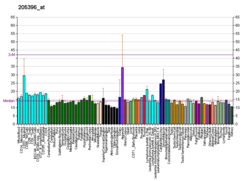SMAD3

Le SMAD3 (pour « Mothers against decapentaplegic homolog 3 ») est une protéine dont le gène est le SMAD3 situé sur le chromosome 15 humain.
Rôle
[modifier | modifier le code]Il intervient dans la voie de signalisation des Smad.
En médecine
[modifier | modifier le code]Une mutation de son gène entraîne un syndrome associant anévrisme aortique thoracique et polyarthrite[5], pouvant être proche d'un syndrome de Loeys-Dietz[6].
Notes et références
[modifier | modifier le code]- GRCh38: Ensembl release 89: ENSG00000166949 - Ensembl, May 2017
- GRCm38: Ensembl release 89: ENSMUSG00000032402 - Ensembl, May 2017
- « Publications PubMed pour l'Homme », sur National Center for Biotechnology Information, U.S. National Library of Medicine
- « Publications PubMed pour la Souris », sur National Center for Biotechnology Information, U.S. National Library of Medicine
- (en) van de Laar IM, Oldenburg RA, Pals G et al. « Mutations in smad3 cause a syndromic form of aortic aneurysms and dissections with early-onset osteoarthritis » Nat Genet, 2011;43:121–126
- (en) Pyeritz R, Jondeau G, Moran R, De Backer J, Arbustini E, De Paepe A, Milewicz D, « Loeys-Dietz syndrome is a specific phenotype and not a concomitant of any mutation in a gene involved in TGF-β signaling » Genet Med, 2014;16:641–642







